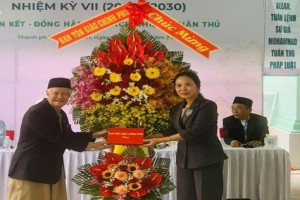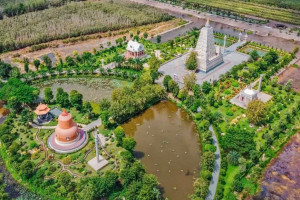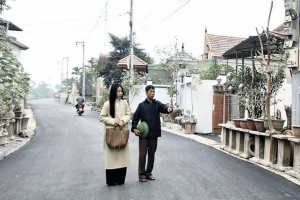
For Vietnamese people, going to Buddhist pagodas on early days of the traditional New Year festival has become an unique spiritual and cultural feature. On occasion of the Lunar New Year 2017, let’s look at Buddhist temples in Vietnam’s bordering areas.
Tan Thanh Pagoda in Lang Son province encompassed an area of 21 hectares and was modeled on the traditional Vietnamese Buddhist architecture. The 2,7ha of the inner area built with the pattern of a combination of a seven-stall main worshipping hall in front, a five-stall ancestral worshipping hall at the rear and a connecting tubed house of three-stall long. The largest structure, the main worshipping hall or Three Jewels Hall, has an area of 1,300m2. All of inner area’s structure was made of iron wood.
Pagodas of Xuan Lan and Co To in Quang Ninh province
Located in Quang Ninh province’s Mong Cai city, Xuan Lan Pagoda was built in the late Le dynasty and recognized as a national relics for architectural arts by the Ministry of Culture, Sports and Tourism in 1999.

Co To Pagoda in Co To Island is the spiritual center and worshipping place of local people and fishermen in the island.
Phat Tich Truc Lam Pagoda, Cao Bang province
The pagoda is situated near Ban Gioc waterfall, Dam Thuy commune, Trung Khanh district, the northern mountainous province of Cao Bang, around 1km from Ta Lung border gate. The construction of Phat Tich Truc Lam was started in June, 2013 on the area of 2 hectares and completed in 2014 with an estimated cost of nearly VND 38 billion.
Phat Tich Truc Lam Pagoda also displays its design following the traditional Vietnamese Buddhist architecture with many worshipping and supporting facilities such as worshipping temples, the three-entrance gate, and a statue of Bodhisattva.

Truc Lam Ta Lung Pagoda in Cao Bang province
Truc Lam Ta Lung Pagoda was built in 2014 on area of 5,300m2 in Ta Lung town. The two-storey three-entrance gate is made of solid bricks and columns of reinforced concrete with a bell on the centre of the 2nd floor, and has embossed couplets (or parallel sentences) in Vietnamese texts.
The architecture of the Three Jewels Hall, the ancestral worshipping hall, a seven-stall main worshipping hall in front and a three-stall house at the rear feature the Vietnamese traditional architectural design.

Main worshipping hall of Truc Lam Ta Lung Pagoda
Sung Khanh Pagoda in Ha Giang province
Sung Khanh Pagoda is located on the summit of Nung village of Dao Duc commune in Vi Xuyen district’s in Ha Giang province - a historical site. The pagoda was built in 1356 and restored in 1705.
The pagoda has still preserved two relics, including a stone stele of Tran dynasty (1367) which recorded merit of the pagoda’s founder; and a bell with 0,90m high and 0.67 m diameter, made from bronze in the late of Le dynasty (1705).

Ho Quoc Temple in Kien Giang province
Ho Quoc Pagoda (also known as Truc Lam Phu Quoc Monastery), considered as a largest Buddhist establishment not only in Phu Quoc Island but also in provinces of Mekong Delta region, was inaugurated in 2011.

Truc Lam Phu Quoc Monastery preserves the traditional architectural design of Dynasties of Ly and Tran when Buddhism flourished in the early history of Vietnam.
Buddhist temples in Truong Sa Island, Khanh Hoa province
Six Buddhist temples in Truong Sa Island has formed a typical Vietnamese architectural, cultural, spiritual and historical complex in the East Sea of Vietnam.

Song Tu Tay Temple is the first Buddhist temple in Truong Sa. It’s modeled on the traditional Vietnamese architecture and built with saltwater-resistant wood. The temple’s statue of Buddha made of precious stone. Wooden decoration boards are red painted and covered with gold, and contain couplets embossed with Vietnamese texts. Together with Buddhist worshipping altars, the temple also built a worshipping altar for heroic martyrs who sacrificed their lives to protect the nation’s sovereignty over its sea and islands.
Sinh Ton Temple is built on area of 500m2, near Sinh Ton Island. Its layout resembles a typical village temple in Northern Vietnamese countryside. On the left side, there is a memorial stele for 64 heroic soldiers who died in the battle of Gac Ma in 1988.

Truong Sa Lon Temple on Truong Sa Lon town is spacious and has a library with full of Buddhist books. The main worshipping hall of the temple places a statue of Buddha made of jade stone, which was the gift from the World Buddhist Federation to Former Prime Minister Nguyễn Tấn Dũng, who later presented it to the temple.
All Buddhist temples in Truong Sa Island have main worshipping halls facing towards Hanoi capital.

Nam Yet Temple in Sinh Ton commune, Truong Sa district is not only a place for meeting religious needs but also a spiritual and cultural center for Vietnamese people in Truong Sa Island.
Son Linh Temple in Son Ca Island was designed with curved roofs and horizontals and couplets deliberately and skillfully carved.
TP (Source: Journal of Buddhist studies No. 1/2017)




